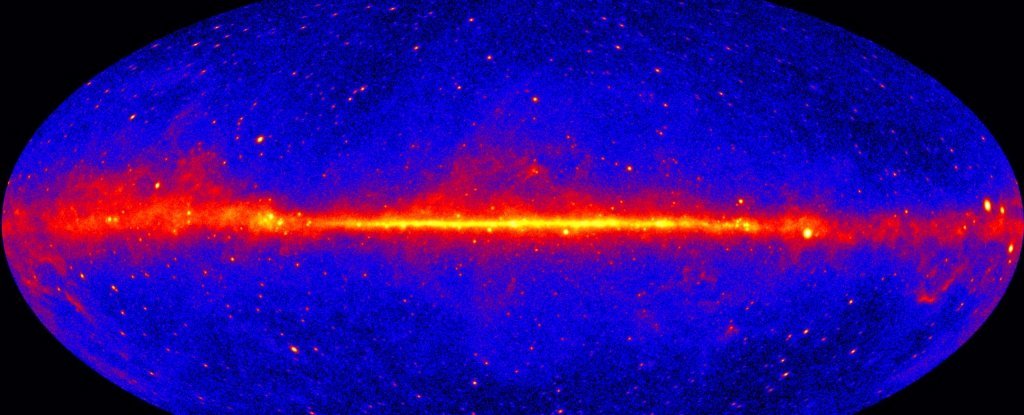article image source: freepik.com (link)
Introduction: A Universe Cloaked in Mystery
For decades, scientists have known that most of the universe is made up of something we can't see — something mysterious, invisible, and powerful. This elusive ingredient is called dark matter, and it makes up about 27% of the universe, compared to just 5% made of ordinary matter like stars, planets, and people. Despite being all around us, dark matter doesn’t emit, reflect, or absorb light, making it impossible to detect directly with traditional telescopes.
advertisement
But recent discoveries are finally pulling back the cosmic curtain. From strange glows at the heart of our galaxy to ancient stars possibly powered by dark matter itself, scientists are starting to piece together one of the universe's biggest puzzles. Here's how modern astronomy is closing in on the shadowy force that holds galaxies together.

image source: sciencealert.com
I. A Glow in the Darkness: Gamma Rays from the Galactic Core
In the heart of our Milky Way, about 26,000 light-years from Earth, astronomers have detected a diffuse glow of gamma rays — the most energetic form of light. This glow, captured by NASA's Fermi Gamma-ray Space Telescope, doesn't match any known source of radiation and stretches across a vast 7,000-light-year region near the galaxy’s center.
Two main theories have been proposed to explain this strange signal:
Colliding dark matter particles that annihilate each other, producing bursts of gamma rays.
Millisecond pulsars — rapidly spinning neutron stars that emit beams of radiation.
A new study by researchers at Johns Hopkins University and the Leibniz Institute for Astrophysics used advanced computer simulations to revisit the data. By factoring in the way our galaxy formed from an ancient cloud of dark and ordinary matter, their models showed that dark matter could explain the gamma-ray glow just as well — if not better — than pulsars.
“This increases the odds that dark matter has been indirectly detected,” said cosmologist Joseph Silk. The team hopes that the upcoming Cherenkov Telescope Array in Chile, expected to begin operations as soon as 2026, will help distinguish between these two possibilities.
image source: sciencedaily.com
II. A Cosmic First? Signs of Stars Powered by Dark Matter
The James Webb Space Telescope (JWST), the most powerful telescope ever built, is revealing a universe stranger than we imagined. A team of scientists analyzing JWST data believes they may have found evidence of “supermassive dark stars” — ancient, giant stars that may have been powered not by nuclear fusion like our Sun, but by dark matter annihilation.
These stars, if confirmed, could explain two cosmic mysteries:
Why some of the earliest galaxies are brighter than expected.
How supermassive black holes formed so quickly after the Big Bang.
Led by Cosmin Ilie and Katherine Freese, the researchers studied distant objects dating back just 300 million years after the Big Bang. Their light signatures — especially an absorption dip at 1640 Angstroms, a key indicator of helium — matched predictions for dark stars.
Though the evidence is still tentative, the idea is groundbreaking. If dark stars truly existed, they not only shed light on the early universe but may also help identify the very particles that make up dark matter.
image source: skyatnightmagazine.com
III. Shadows in Space: Discovering a Tiny, Massive Dark Object
While massive stars and gamma-ray glows offer indirect signs of dark matter, some of the most intriguing evidence comes from the gravitational effects it has on light. In a process called gravitational lensing, a massive object bends the light from a background galaxy — a phenomenon first predicted by Einstein.
Using a global network of radio telescopes, including the Green Bank Telescope in West Virginia and the Very Long Baseline Array in Hawaii, astronomers have detected a dark object with a mass about 1 million times that of our Sun. It’s the smallest dark object ever found using this method.
What’s remarkable is that it’s completely invisible. It emits no light or radiation — its presence was only revealed by the way it distorted light passing near it. Scientists believe it may be either:
A clump of dark matter — smaller than anything previously observed, or
A faint dwarf galaxy too dim to see.
“Finding low-mass objects like this is critical for learning about the nature of dark matter,” said astronomer Chris Fassnacht of UC Davis. It suggests that dark matter may clump together in smaller structures than previously thought — and that we can detect them using their gravitational fingerprints alone.
Conclusion: Dark Matter, Closer Than Ever
For something that we can't see, dark matter is starting to show itself in remarkable ways. From gamma-ray glows at the center of our galaxy, to the possible discovery of dark matter-powered stars, to invisible objects warping light across the universe, the evidence is building — slowly, but surely.
While no single study has yet provided a “smoking gun,” these discoveries are converging on a deeper understanding of the dark universe. Each telescope, simulation, and observation adds a new piece to the puzzle.
And perhaps most inspiring of all: the quest to understand dark matter is not just about discovering something hidden. It's about reshaping how we understand the universe itself — from the first stars and galaxies to the fate of cosmic structures yet to form.
As new telescopes like the Cherenkov Array and JWST continue scanning the skies, and as physicists refine their theories, we may soon answer one of the biggest questions in modern science: What is the invisible matter that binds the cosmos together?
Until then, the search continues — in the shadows, at the edge of light.
✍ Sources:
➤ Reuters – “Scientists move closer to confirming existence of dark matter” (Oct 16, 2025)
➤ Daily Mail – “Mysterious dark matter is seen for the first time” (Oct 2025)
➤ USA Today – “Mysterious faraway cosmic object could be dark matter or dwarf galaxy” (Oct 13, 2025)
Thank you !







